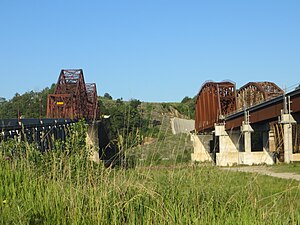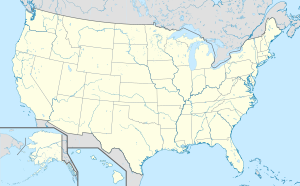Plattsmouth Railroad Bridge
Coordinates: 41 ° 0 ′ 6 " N , 95 ° 52 ′ 2" W.
| Plattsmouth Railroad Bridge | ||
|---|---|---|
| The Plattsmouth Railroad Bridge from 1903 (right), from 2013 (center) and road bridge from 1929 (left) | ||
| use | Railway bridge | |
| Crossing of | Missouri River | |
| place | Plattsmouth , Nebraska and Mills County , Iowa | |
| Entertained by | BNSF Railway | |
| construction | Truss bridge | |
| overall length | 907 m | |
| Longest span | 123 m | |
| building-costs | 46 million US dollars (2013) | |
| opening | 1880, 1903, 2013 | |
| planner |
George S. Morison (1880) Edward J. Blake (1903) BNSF Railway (2013) |
|
| location | ||
|
|
||
The name Plattsmouth Railroad Bridge refers to two neighboring single-track railroad bridges over the Missouri between Plattsmouth in Nebraska and Mills County in Iowa since 2013 . The namesake of the bridges and the city of Plattsmouth is the mouth of the Platte in the Missouri, a few kilometers to the north . The bridges date back to one of the first railroad bridges over the river from 1880, which was built by George S. Morison for the Chicago, Burlington and Quincy Railroad (CB&Q). Due to the rapid development of locomotives and freight volumes, it had to be replaced in 1903 by a bridge with a higher load capacity. The CB&Q went on in 1970 in the Burlington Northern Railroad , which in turn merged in 1995 with the current operator BNSF Railway . Due to the increased volume of traffic on the main line of the BNSF between Lincoln and Chicago , the railway company built a new parallel bridge by 2013, but the bridge, which is over a hundred years old, is still used for shunting empty trains.
In the immediate vicinity there is a road bridge built in 1929 downstream , which led US Highway 34 until 2014 and has been a listed building since 1993 .
First bridge 1880

In early 1879, Charles Elliott Perkins , President of CB&Q, hired the young civil engineer George S. Morison to build a railway bridge in Plattsmouth. It was only Morison's second self-constructed bridge and his first across the Missouri. In contrast to all previous bridges over the river, Morison built a high bridge without a movable bridge part and was able to convince Perkins of the advantages, because due to the predominantly high bank embankment on the Missouri, these were cheaper to build and also to maintain than the usual swing bridges . Morison worked here for the first time as an assistant with the civil engineer Charles Conrad Schneider , who originally came from Apolda in Thuringia , Morison assisted on other bridges until 1883 and later designed the Washington Bridge (1889) in New York, among other things . For Morison, the bridge was the beginning of a career as one of the leading bridge construction engineers of his time and he would later construct over twenty large railway bridges, nine more over the Missouri and another five for Perkins and the CB&Q.
The main part of Morison's bridge were two parallel- belted 123-meter-long wrought-iron Whipple trusses over the navigation channel (English whipple truss , after its inventor Squire Whipple , 1804–1888) with an underlying track, to which three smaller approximately 60-meter-long trusses are attached on the east side with the overhead track, followed by a trestle bridge as an access road with a total length of almost 440 meters. The access on the west side consisted of a short trestle bridge 37 meters in length. The lattice girders were erected on six brick-built stone pillars, with the river pillars being built using caissons down to the depth of the bedrock. Construction began on August 17, 1879 and on August 30, 1880 the first train was able to pass the bridge.
Second bridge 1903


Morison's bridge was designed for a load capacity of two 75 ton locomotives , which turned out to be insufficient after the turn of the century due to the rapid development of locomotives and freight volumes and prompted the CB&Q to build a new one. According to the plans of Edward J. Blake, the old bridge was replaced in 1903 by a new one with a load capacity of around two 150-tonne locomotives . For this purpose, only the first long truss on the east side was replaced by an equally long steel girder , in the construction developed by the Pennsylvania Railroad with a curved upper belt (Pennsylvania truss) . The second 123-meter Whipple truss was replaced with the shorter girders with an overhead track by stronger 60-meter-long, parallel - belt Pratt trusses , made of steel, after its inventors Caleb and Thomas Willis Pratt, 1812-1875 an additional bridge pier had to be built in the river. The work was carried out by CB&Q, with steel components manufactured by the American Bridge Company .
Third bridge 2013
The Chicago, Burlington and Quincy Railroad merged with the Burlington Northern Railroad in 1970 , which merged with the BNSF Railway in 1995 . The bridge connection is part of the BNSF's main line between Lincoln , Nebraska and Chicago , Illinois . The volume of traffic has tripled since the 1980s to nearly 50 trains a day early 2010s, whereby in addition to freight trains BNSF also Amtrak - passenger trains operate over the connection. The maintenance requirements for the almost hundred-year-old bridge increased steadily over the years and the BNSF analyzed several options for maintaining the Missouri River in the future. The decision was made to build a more cost-effective new building about 18 meters downstream next to the old bridge, which was to be retained for the time being. Between 2012 and 2013, the BNSF built the new single-track bridge with a total length of 907 meters, which, like its neighboring bridge, has a 123-meter-long truss over the river, but which is in Warren truss , after its inventor James Warren, 1806–1908) is designed with a curved top chord and is complemented by a large number of girder bridges . The new bridge was inaugurated on December 4, 2013. For the time being, the old bridge will continue to be used by the BNSF for shunting empty trains, but future use, overhaul or dismantling will be decided depending on the development of the traffic volume.
Web links
- Plattsmouth Railroad Bridge. Bridgehunter.
- BNSF - Plattsmouth Rail Bridge (New). Bridgehunter.
- Plattsmouth Bridge, Spanning Missouri River, Plattsmouth, Cass County, NE. Historic American Engineering Record, HAER NE-5.
literature
- Clayton B. Fraser: Nebraska City Bridge. Historic American Engineering Record, HAER No. NE-2, Denver, Colorado 1986, pp. 37-68.
- George S. Morison: The Plattsmouth Bridge: A Report to Charles E. Perkins, President of the Chicago, Burlington, and Quincy Railroad. New York 1882.
- Nick Staroski, Scott M. Mackiewicz, Larry D. Woodley: Design Challenges of BNSF Bridge 3.8 over the Missouri River near Plattsmouth, NE. In: Proc. of the 2013 Annual Conference. American Railway Engineering and Maintenance-of-Way Association (AREMA) September 29 - October 2, 2013, Indianapolis, Indiana, pp. 863-888.
Individual evidence
- ^ Clayton B. Fraser: Nebraska City Bridge. Historic American Engineering Record, HAER No. NE-2, Denver, Colorado 1986, pp. 37-68.
- ↑ George S. Morison: The Plattsmouth Bridge: A Report to Charles E. Perkins, President of the Chicago, Burlington, and Quincy Railroad. New York 1882, pp. 3, 10-18, 23 and 37.
- ^ The Plattsmouth Bridge of the Burlington. In: Railroad Gazette. Vol. 35, No. 32, 1903, p. 564 f.
- ↑ New BNSF bridge at Plattsmouth now open. In: Lincoln Journal Star. December 12, 2013, accessed March 30, 2018.
- ↑ Nick Staroski, Scott M. Mackiewicz, Larry D. Woodley: Design Challenges of BNSF Bridge 3.8 over the Missouri River near Plattsmouth, NE. In: Proc. of the 2013 Annual Conference. American Railway Engineering and Maintenance-of-Way Association (AREMA), September 29 - October 2, 2013, Indianapolis, Indiana, pp. 863-888, here pp. 863-866.

